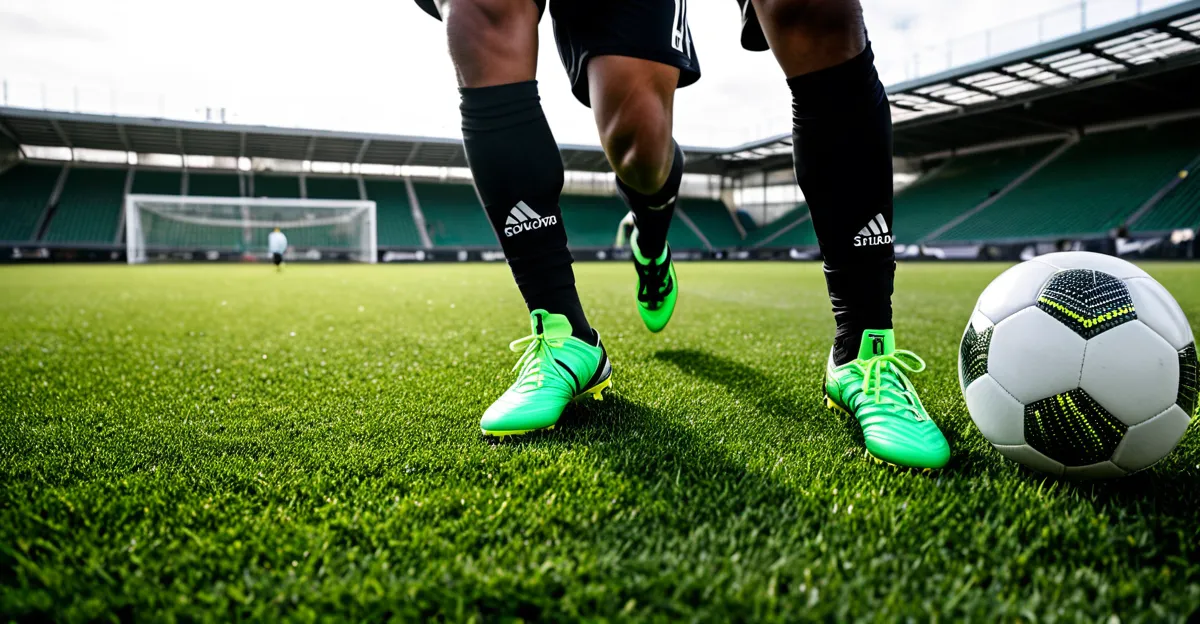Latest Advancements in Soccer Turf Technology
Recent developments in soccer turf technology emphasize both innovation and performance enhancement. Contemporary turf systems now incorporate innovative turf materials, engineered to mimic natural grass while offering greater durability and consistent playability. These materials often blend synthetic fibers with advanced infill to provide resilience, reduce maintenance, and maintain optimal surface conditions in various weather.
Cutting-edge training surfaces now include specialized designs that improve ball roll, traction, and player stability. For instance, advancements in fiber shape and density allow better control over surface stiffness and cushioning, directly influencing how the game feels and unfolds. This integration of precise engineering has brought surfaces closer to the ideal playing experience expected by athletes and coaches.
Have you seen this : Decoding brexit’s impact on international soccer players in english leagues
Moreover, leading-edge turf technology features embedded in modern installations include drainage innovations and UV stabilization, significantly extending field lifespan and usability. These enhancements ensure the surface remains consistent over time, reducing variability that can affect player performance. In sum, the fusion of innovative turf materials with sophisticated design creates soccer surfaces that elevate both training quality and match conditions.
Latest Advancements in Soccer Turf Technology
Recent breakthroughs in soccer turf technology center on innovative turf materials and engineering designed to optimize both performance and durability. Advances have led to the development of cutting-edge training surfaces that closely mimic natural grass, enhancing player experience and reducing maintenance demands.
In the same genre : Revolutionary innovations enhancing player performance analytics for football coaches
Among the most significant innovations are hybrid turf systems that combine synthetic fibers with natural grass roots, creating a resilient, even playing field. These surfaces utilize engineered infills that improve ball roll consistency and traction, directly influencing game quality and safety.
Additionally, the integration of micro-structured surface designs allows for better water drainage and temperature regulation. Such features minimize game disruptions and maintain ideal playing conditions regardless of weather fluctuations, crucial for professional soccer training environments.
The latest turf technologies also introduce smart materials that adjust surface firmness dynamically, supporting varied training requirements. These cutting-edge systems deliver uniform shock absorption and responsiveness, addressing both player comfort and injury prevention.
By combining material science with advanced engineering, modern soccer turf technology delivers superior training surfaces that elevate performance capabilities while meeting the rigorous demands of frequent, high-intensity soccer training.
Enhancing Player Performance and Training Methods
The evolution of soccer turf technology directly benefits player performance by providing surfaces that enhance agility, speed, and control. Modern training methods leverage these advancements by designing drills that exploit the uniformity and responsiveness of turf engineered with innovative turf materials. Such materials optimize traction and cushioning, enabling players to train longer with reduced fatigue and improved movement precision.
How does the surface impact skill development? Studies show that cutting-edge training surfaces improve players’ ability to execute sharp turns and sudden stops while maintaining balance. This means training on advanced turf translates to better real-game performance by reinforcing muscle memory in controlled conditions.
Additionally, the characteristics of these surfaces—like adjustable firmness and shock absorption—can be tailored to specific training goals. For instance, softer turf minimizes impact during high-intensity sessions, protecting joints and supporting injury prevention, whereas firmer surfaces foster faster ball roll and quicker foot response.
In sum, the integration of advanced soccer turf technology and innovative turf materials is reshaping contemporary soccer training approaches. It allows coaches to design scientifically-informed programs that maximize skill acquisition and physical development while prioritizing player safety. This synergy between turf technology and training methods marks a significant leap forward in athlete preparation.
Smart Surfaces and Data-Driven Soccer Training
Smart sports surfaces are transforming soccer training by integrating sensor technology in soccer fields. These sensors embed seamlessly into cutting-edge training surfaces, continuously collecting data on player movements, speed, and load. This data integration allows precise monitoring, providing coaches with real-time feedback on performance and fatigue levels.
How does this technology improve training? By analyzing metrics such as acceleration, deceleration, and joint impact, trainers can adjust drills to optimize individual development while reducing injury risks. Smart surfaces capture movement patterns that were previously challenging to quantify, offering insights to refine technique and endurance.
Additionally, data-driven approaches enable personalized training plans. Players receive tailored feedback based on objective measurements obtained directly from the innovative turf materials they perform on. This ensures that training intensity aligns with each athlete’s condition, promoting gradual progression and recovery.
The use of smart technology in soccer turf also supports long-term performance tracking, helping identify trends and prevent overtraining. With these systems, clubs and academies gain a competitive edge by combining advanced surface design with actionable data, enhancing both player development and overall team strategy in modern soccer training environments.
Player Safety: Injury Prevention and Enhanced Comfort
Ensuring player safety is paramount in modern soccer turf technology, and recent innovations focus heavily on reducing injury risk. Advanced shock absorption technologies embedded in cutting-edge training surfaces provide consistent cushioning that lessens joint stress during intense play and training sessions. By carefully engineering surface responsiveness, these turfs absorb impact forces, thereby lowering the likelihood of common injuries such as sprains and strains.
How do these materials prevent injuries? The answer lies in their ability to distribute and mitigate forces effectively. Surfaces utilizing innovative turf materials balance firmness with flexibility to support natural player movements while minimizing harsh ground reaction forces. This adaptive cushioning reduces fatigue and protects joints over time.
Several studies correlate modern turf systems with noticeable drops in injury rates. For instance, fields equipped with optimized shock absorption features report fewer impact-related accidents and quicker recovery periods, affirming their practical benefits.
Moreover, enhanced surface comfort encourages players to perform at their best without hesitation, promoting confidence and fluidity in movement. The synergistic effect of injury prevention and comfort contributes significantly to sustained athletic performance, validating the investment in such advanced soccer turf technology.
Player Safety: Injury Prevention and Enhanced Comfort
Advanced soccer turf technology prioritizes player safety by integrating superior shock absorption technologies that significantly reduce injury risks. How exactly do these innovations protect athletes? Modern turf systems are engineered to offer a controlled surface responsiveness that lessens joint strain and softens impacts during intense movements. This means players experience reduced forces on knees and ankles, key areas prone to injuries in soccer.
The role of shock absorption extends beyond comfort—it actively contributes to injury prevention by minimizing wear and tear on connective tissues. For example, turf materials with calibrated cushioning absorb landing forces effectively, lowering the incidence of common injuries such as sprains and stress fractures.
Additionally, advanced turf surfaces maintain consistent firmness, providing stable footing which reduces slips and falls. This stability not only enhances safety but encourages confident, high-speed maneuvers with less hesitation.
Case studies from professional clubs confirm that fields with these safety features see measurable declines in acute injuries and long-term joint issues. As such, innovations in innovative turf materials and surface engineering are essential in fostering safer, more comfortable playing conditions for athletes at all levels.
Case Studies: Leading Innovations in Soccer Turf
Examining breakthrough turf products through real-world examples reveals how soccer turf technology translates into tangible benefits. Numerous professional club adoption cases highlight improved player outcomes linked to the use of innovative turf materials combined with cutting-edge training surfaces.
FIFA-approved facilities incorporate hybrid turf systems that blend synthetic fibers with natural grass, ensuring durability and optimal playability under high usage conditions. These systems showcase exceptional ball roll consistency and enhanced traction. Their success in elite training centers validates ongoing research into surface engineering.
University research projects contribute by customizing turf properties to meet specific athletic and environmental demands. For instance, tailored infill compositions and fiber densities optimize shock absorption and surface responsiveness, addressing localized injury prevention concerns effectively.
Professional clubs adopting smart turf solutions benefit from integrated sensors and data analytics, which monitor surface conditions and player interactions. This feedback loop supports maintenance decisions and individual training adaptations, illustrating the synergy between material innovation and technological integration.
These soccer turf case studies collectively demonstrate how targeted application of advanced materials and design features not only elevates training quality but also underlines the strategic value of investing in modern turf technologies for competitive advantage.
Latest Advancements in Soccer Turf Technology
Recent breakthroughs in soccer turf technology focus heavily on refining innovative turf materials and cutting-edge training surfaces to boost both durability and playability. Synthetic fiber innovations now emulate natural grass textures more closely, improving ball interaction and player footing. This level of material precision enhances surface uniformity, which directly impacts game quality.
Advanced turf engineering integrates micro-structured surface designs that optimize water drainage and thermal regulation. These design features allow playability under diverse weather conditions, preventing surface degradation and maintaining consistent performance standards. The result is a field that performs reliably across extended seasons with minimal maintenance.
Current systems embed leading-edge technologies such as UV stabilization and anti-microbial infills, which extend turf lifespan and preserve hygiene. Additionally, these surfaces incorporate responsive cushioning layers calibrated to balance firmness with shock absorption. This technical advancement supports player comfort while mitigating fatigue during prolonged activity.
In specific terms, these innovations translate to soccer fields that deliver consistent traction, quick ball roll, and improved player stability. The synergy between material advancements and engineering innovations in soccer turf technology is reshaping the playing field—literally—by delivering top-tier surfaces engineered for performance and longevity.






